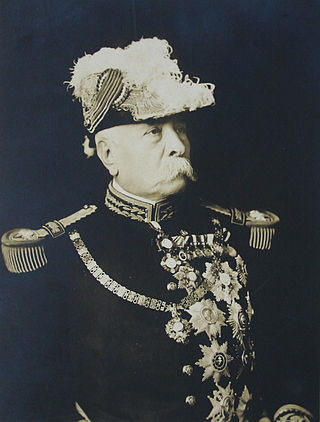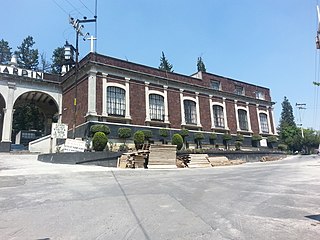
José de la Cruz Porfirio Díaz Mori, known as simply Porfirio Díaz, was a Mexican general, politician, and later dictator who served seven terms as President of Mexico, a total of 35 years, from 28 November 1876 to 6 December 1876, 17 February 1877 to 1 December 1880, and 1 December 1884 to 25 May 1911. The entire period from 1876 to 1911 is often referred to as the Porfiriato, and has been characterized as a de facto dictatorship.

Juan Nepomuceno Álvarez Hurtado de Luna, generally known as Juan Álvarez, was a general, long-time caudillo in southern Mexico, and president of Mexico for two months in 1855, following the liberals' ouster of Antonio López de Santa Anna. His presidency inaugurated the pivotal era of La Reforma.

Soldaderas, often called Adelitas, were women in the military who participated in the conflict of the Mexican Revolution, ranging from commanding officers to combatants to camp followers. "In many respects, the Mexican revolution was not only a men's but a women's revolution." Although some revolutionary women achieved officer status, coronelas, "there are no reports of a woman achieving the rank of general." Since revolutionary armies did not have formal ranks, some women officers were called generala or coronela, even though they commanded relatively few men. A number of women took male identities, dressing as men, and being called by the male version of their given name, among them Ángel Jiménez and Amelio Robles Ávila.

Jerécuaro is a Mexican city located in the lowlands of the state of Guanajuato. The municipality has an area of 828.3 square kilometres and is bordered to the north by Apaseo el Alto, to the east by Coroneo and the state of Querétaro, to the south by Tarandacuao, to the southwest with Acámbaro, and to the northwest with Tarimoro. The municipality had 55,311 inhabitants according to the 2005 census. The municipal president of Jerécuaro and its many smaller outlying communities is C.Jaime García Cardona.

The 15th Pan American Games were held in Rio de Janeiro, Brazil from 13 to 29 July 2007. Mexico participated with 400 athletes and 218 staff members.

Mañana es para siempre is a Mexican telenovela produced by Nicandro Díaz González for Televisa in 2008. It is an adaption of the 2007 Colombian telenovela Pura sangre. It aired on Canal de las Estrellas from October 20, 2008 to June 12, 2009.
Guadalupe Gracia García-Cumplido was a Mexican military surgeon with the rank General Brigadier Médico Cirujano.
Alondra is a Mexican telenovela produced by Carla Estrada for Televisa in 1995. The story based on Casandra created by Yolanda Vargas Dulché. For personal reasons Yolanda Vargas Dulché changed the name of Casandra to Alondra in honor of her granddaughter Alondra de la Parra. It stars Gonzalo Vega, Ana Colchero and Ernesto Laguardia.
Arizmendi is a Spanish surname. It is the castilianized form of the Basque surname Arismendi, formed from aritz (oak) + mendi (mountain).

Jovita Idar Vivero was an American journalist, teacher, political activist, and civil rights worker who championed the cause of Mexican Americans and Mexican immigrants. Against the backdrop of the Mexican Revolution, which lasted a decade from 1910 through 1920, she worked for a series of newspapers, using her writing to work towards making a meaningful and effective change. She began her career in journalism at La Crónica, her father's newspaper in Laredo, Texas, her hometown.
Hispanic and Latino women in America have been involved in journalism for years, using their multilingual skills to reach across cultures and spread news throughout the 19th century until the common era. Hispanic presses provided information important to the Hispanic and Latin American communities and helped to foster and preserve the cultural values that remain today. These presses also "promoted education, provided special-interest columns, and often founded magazines, publishing houses, and bookstores to disseminate the ideas of local and external writers."
José Darío María Pico was member of the Pico family of California, an important Californio family to Southern California. He was a soldier in the Company of San Diego since 1782, corporal at Mission San Luis Rey (1798) and sergeant (1805–1818).
Las delicias del poder is a 1999 Mexican political satire comedy film directed by Iván Lipkies starring María Elena Velasco as La India María with Ernesto Gómez Cruz, Irma Dorantes, and Adalberto Martínez. The film broke the box-office record in Mexico at the time of its release, earning 11 million pesos and having been the second-highest grossing film of the year.
Leonor Villegas de Magnón was a Mexican-American political activist, teacher, and journalist who founded a brigade of the international Mexican American relief service, La Cruz Blanca, during the Mexican Revolution.

The Mexican Red Cross is a non-governmental humanitarian assistance organization affiliated with the International Federation of Red Cross and Red Crescent Societies to help those in dangerous situations, such as natural disasters, as well as providing human health services. The organization finances its aid, assistance, and education programs through the work of thousands of volunteers and donation from individuals, institutions, organizations, associations and companies. It originated with a presidential decree in 1910 and was recognized internationally in 1912. Today it participates in national and international aid and disaster relief missions as well as various health services, training in first aid and for emergency medical technicians. Early in its history, it developed a program in nursing, which eventually became the Escuela Nacional de Enfermería y Obstetricia, today part of the National Autonomous University of Mexico.

Elena Arizmendi Mejía was a Mexican feminist who established the Neutral White Cross to care for casualties of the Mexican Revolution that the Red Cross would not aid. Participating in the first wave of Mexican feminism, she established two international women's rights organizations: the "Mujeres de la Raza" and the International League of Iberian and Latin American Women.
El vuelo del águila is a Mexican telenovela produced by Ernesto Alonso and Carlos Sotomayor for Televisa in 1994–1995. Telenovela based on the Mexican soldier and President of Mexico Porfirio Díaz, from his name had come out the title "Época Porfiriana" or "Porfiriato" during the period of his rule, in the years 1876–1911.

Sara Pérez Romero, also known as Sara Pérez de Madero, was a Mexican politician and activist who served as First Lady of Mexico from 1911 to 1913, as the wife of Francisco I. Madero, the 37th President of Mexico. Together with Carmen Serdán Alatriste and Aquiles Serdán Alatriste, she formed a group which supported the anti-reelectionist party in the days before the outbreak of the Mexican Revolution. Pérez Romero was also known as the "First Lady of the Revolution" or by her nickname, Sarita.

Panteón Jardín is a cemetery in Mexico City in which several notable people are interred. It is located in the southwest of the city, between the San Ángel and Olivar de los Padres boroughs.












